Aquariums reduce stress by creating a calming environment that engages your senses and promotes relaxation. The gentle movement of fish, soothing blue-green colors, and soft bubbling sounds can lower your blood pressure and heart rate. To set up a therapeutic aquarium, choose a tank size that fits your space, select peaceful fish species, and design a balanced aquascape. Incorporate natural elements, use warm lighting, and maintain pristine water quality for maximum benefits. Regular maintenance routines and mindfulness exercises can enhance your aquarium's stress-reducing effects. By following these guidelines, you'll transform your space into a tranquil oasis that offers numerous health benefits.
The Science Behind Aquarium Therapy
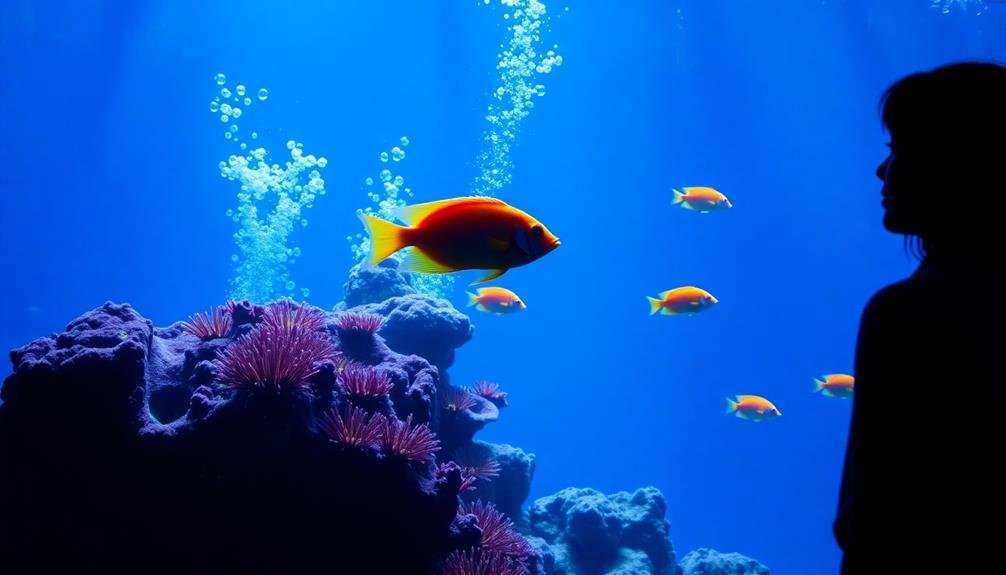
Often, the calming effects of aquariums aren't just anecdotal; they're backed by scientific research. Studies have shown that watching fish swim can lower blood pressure, reduce heart rate, and decrease anxiety levels. This therapeutic effect is linked to the way our brains process the visual stimuli of an aquarium.
When you observe fish swimming, your mind enters a meditative state. The repetitive, gentle movements of aquatic life trigger the release of endorphins, your body's natural feel-good chemicals.
Additionally, the sound of bubbling water acts as white noise, helping to mask disruptive background sounds and promote relaxation.
The colors in an aquarium also play a role. Blues and greens, commonly found in aquatic environments, have been proven to have a soothing effect on the human psyche. These colors can lower stress levels and improve mood.
Interacting with aquariums can also increase your focus and attention span. The act of caring for fish and maintaining the aquarium environment provides a sense of purpose and accomplishment, contributing to overall well-being and mental health.
Choosing the Right Tank Size
When selecting an aquarium for therapeutic purposes, size matters considerably. You'll want to strike a balance between visual impact and practicality. A tank that's too small may limit your options for fish and decorations, while one that's too large can be overwhelming to maintain.
For most home or office settings, a 20 to 55-gallon tank is ideal. This size range offers enough space for a diverse ecosystem without dominating the room. It's large enough to create an engaging focal point but manageable for beginners.
If you're tight on space, don't dismiss smaller tanks. A well-designed 10-gallon setup can still provide therapeutic benefits. However, you'll need to be more selective with fish choices and may require more frequent maintenance.
For maximum impact in larger spaces, consider tanks of 75 gallons or more. These allow for more complex aquascapes and larger fish species, creating a truly immersive experience.
Remember, though, that bigger tanks require more time, effort, and resources to maintain properly.
Ultimately, choose a size that fits your available space, maintenance capabilities, and desired visual impact. The right tank size will enhance your therapeutic experience without becoming a burden.
Calming Fish Species Selection
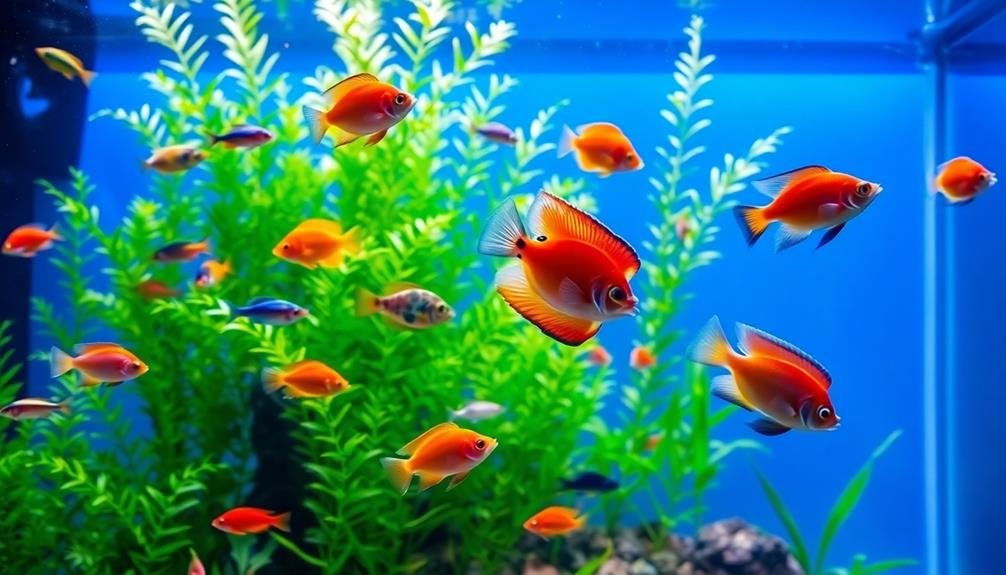
When selecting fish for your therapeutic aquarium, you'll want to focus on peaceful breeds that contribute to a calming atmosphere.
Consider species like bettas, guppies, or neon tetras, known for their gentle nature and low-stress behaviors.
You can choose between vibrant, colorful fish that add visual interest or opt for more subtle hues that blend seamlessly into a tranquil underwater scene.
Best Peaceful Fish Breeds
Selecting the right fish species is essential for creating a calming therapeutic aquarium. You'll want to choose peaceful, non-aggressive fish that move gracefully through the water.
Bettas, with their flowing fins and vibrant colors, can be mesmerizing to watch, but they're best kept alone or with careful selection of tankmates. Guppies are another excellent choice, offering a variety of colors and patterns while maintaining a gentle demeanor.
For a serene underwater scene, consider adding a school of neon tetras. Their synchronized swimming and shimmering blue stripes create a hypnotic effect.
Angelfish, with their elegant, triangular bodies, glide smoothly through the water and add a touch of majesty to your tank. If you're looking for bottom-dwellers, cory catfish are peaceful scavengers that help keep your aquarium clean.
Rasboras, such as the harlequin rasbora, are small, peaceful fish that school together, creating a soothing, coordinated movement.
Colorful vs. Subtle Choices
Balance is key when choosing between colorful and subtle fish species for your therapeutic aquarium. While vibrant, eye-catching fish can create a visually stimulating environment, they may also be more energetic and require more attention.
On the other hand, subtle-colored fish often have a calming effect and can blend seamlessly with your aquarium's décor.
Consider your personal preferences and stress-relief needs when making your selection. If you find bright colors invigorating, opt for species like neon tetras, guppies, or discus fish. These colorful creatures can add life and excitement to your tank.
However, if you're looking for a more subdued atmosphere, choose fish with muted tones such as pearl gouramis, zebra danios, or cherry barbs.
You don't have to limit yourself to one extreme. Mixing both colorful and subtle fish can create a balanced, visually appealing aquarium.
Try pairing a few standout species with a larger group of calmer fish. This combination will provide visual interest without overwhelming the senses, allowing you to enjoy the therapeutic benefits of your aquarium fully.
Soothing Aquascape Design Principles
When creating a therapeutic aquarium, you'll want to focus on incorporating natural elements and achieving visual balance in your aquascape.
Consider using rocks, driftwood, and live plants to mimic underwater landscapes and create a sense of harmony.
You can enhance the soothing effect by applying color harmony techniques, such as using complementary or analogous color schemes in your aquatic plants and substrate choices.
Natural Elements and Balance
Nature's harmony serves as the foundation for creating soothing aquascape designs in therapeutic aquariums. To achieve this balance, you'll need to incorporate various natural elements that mimic underwater ecosystems.
Start by selecting a diverse range of aquatic plants, from tall background species to shorter foreground varieties. These plants not only provide oxygen but also create a sense of depth and tranquility.
Next, focus on your hardscape elements. Use rocks, driftwood, and natural substrates to create a realistic underwater landscape. Arrange these elements asymmetrically to enhance visual interest and flow.
Consider the rule of thirds when placing focal points to create a more aesthetically pleasing composition.
Don't forget about the importance of negative space. Leaving open areas in your aquascape allows for visual rest and enhances the overall sense of balance.
Pay attention to color harmony as well, choosing plants and fish that complement each other and create a cohesive look.
Color Harmony Techniques
Color harmony plays an essential role in creating a soothing aquascape design. When setting up your therapeutic aquarium, you'll want to take into account how different hues interact to create a calming atmosphere. Start by choosing a dominant color for your aquascape, typically blue or green, which naturally evoke a sense of tranquility.
Complement your main color with analogous hues, those adjacent on the color wheel. For example, pair blue with turquoise and violet, or green with yellow-green and blue-green. This creates a harmonious, cohesive look that's easy on the eyes. You can also incorporate accent colors sparingly to add visual interest without overwhelming the senses.
Take into account the color temperature of your lighting, opting for warmer tones to create a cozy ambiance. Cool white lights can make the aquarium feel clinical and less relaxing.
Don't forget about the colors of your fish, plants, and substrate. Choose species and materials that complement your overall color scheme. Avoid clashing colors or overly bright elements that might disrupt the peaceful atmosphere you're trying to achieve.
Optimal Lighting for Relaxation
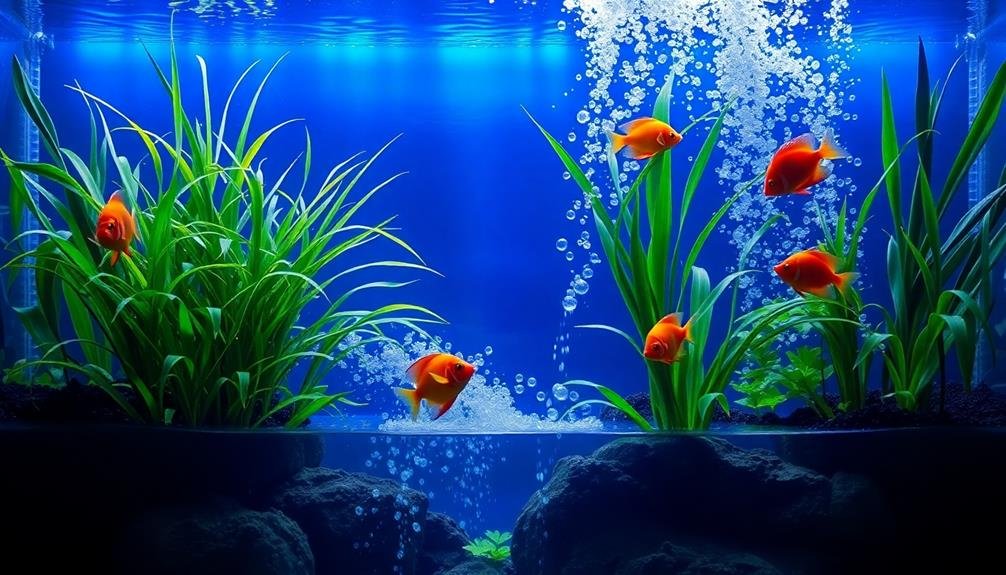
Ideal lighting plays an essential role in creating a relaxing aquarium environment. You'll want to strike a balance between showcasing your aquatic life and maintaining a calming atmosphere.
Opt for adjustable LED lighting systems that allow you to control intensity and color. Softer, warmer tones are generally more soothing than harsh, bright lights.
Consider implementing a day-night cycle to mimic natural lighting conditions. This not only benefits your fish but also creates a more authentic and tranquil viewing experience.
Gradually dimming the lights in the evening can signal your brain that it's time to wind down, making your aquarium an excellent addition to your bedtime routine.
For maximum relaxation, experiment with these lighting techniques:
- Use blue or moonlight LEDs for a serene nighttime ambiance
- Incorporate floating plants to diffuse light and create dappled shadows
- Install a dimmer switch to easily adjust light intensity
- Add subtle backlighting to create depth and reduce eye strain
Water Quality and Stress Reduction
Maintaining pristine water quality in your therapeutic aquarium isn't just crucial for your fish—it's essential for your stress reduction too. Clean, clear water enhances the visual appeal and promotes a sense of tranquility. To achieve this, you'll need to establish a regular maintenance routine.
Start by investing in a quality filtration system that matches your tank size. This will help remove debris, toxins, and excess nutrients. Perform partial water changes weekly, replacing about 10-20% of the water. Use a gravel vacuum to remove waste from the substrate during these changes.
Monitor key water parameters like pH, ammonia, nitrite, and nitrate levels using test kits. Aim for stable readings within the appropriate range for your fish species. Consider adding live plants to help naturally filter the water and create a more balanced ecosystem.
Avoid overfeeding, as excess food can quickly degrade water quality. Remove any uneaten food promptly.
Keep an eye out for algae growth and address it early to prevent unsightly blooms. By maintaining excellent water quality, you'll create a more serene and stress-reducing aquatic environment for both you and your fish.
Maintenance Routines for Zen
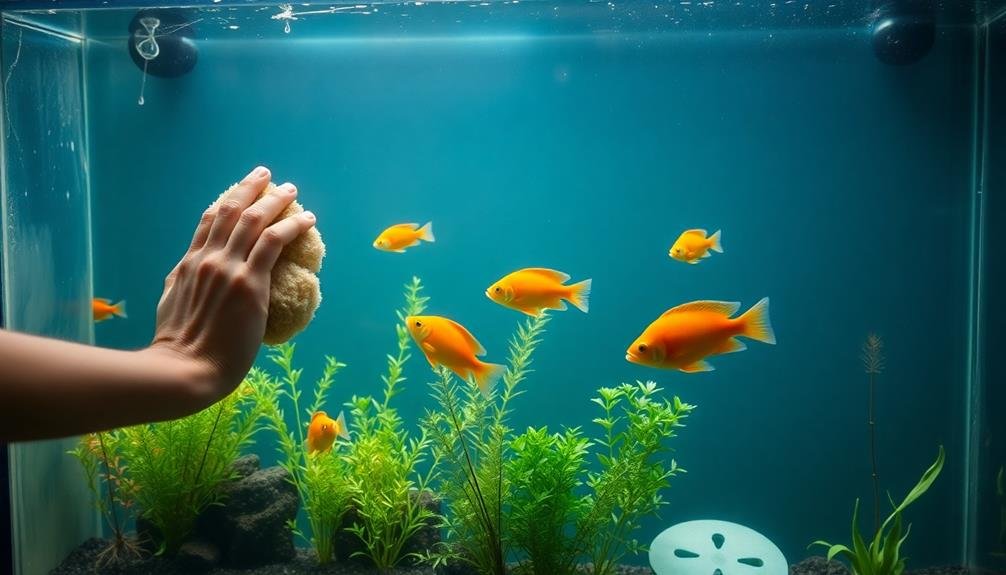
To maintain a zen-like atmosphere in your therapeutic aquarium, you'll need to establish a regular cleaning schedule and consistently monitor water parameters.
You should also focus on pruning plants and rearranging decor to keep the underwater landscape fresh and appealing.
Regular Cleaning Schedule
A consistent cleaning routine is essential for keeping your therapeutic aquarium in pristine condition.
You'll want to establish a weekly schedule that covers all aspects of maintenance. Start by performing a partial water change, replacing about 10-20% of the tank's volume with fresh, treated water. This helps remove accumulated toxins and replenishes essential minerals.
Next, clean the glass or acrylic walls using an algae scraper or magnetic cleaner. Don't forget to wipe down the exterior surfaces to maintain a clear view.
Vacuum the substrate to remove debris and uneaten food, paying special attention to corners and plant bases.
Check and clean your filtration system regularly, rinsing media in old tank water to preserve beneficial bacteria. Trim any overgrown plants and remove dead leaves to maintain a balanced ecosystem.
To stay organized, create a cleaning checklist that includes:
- Water testing and parameter adjustments
- Equipment inspection (heaters, pumps, lights)
- Algae control measures
- Fish health assessment
Monitoring Water Parameters
Water quality forms the foundation of a healthy therapeutic aquarium. To maintain ideal conditions, you'll need to monitor key parameters regularly. Invest in a reliable test kit that measures pH, ammonia, nitrite, and nitrate levels. Aim to check these weekly, or more frequently if you notice any changes in fish behavior or water clarity.
Keep pH levels stable, typically between 6.8 and 7.8 for most freshwater setups. Ammonia and nitrite should always read zero, while nitrate levels should remain below 20 ppm. If you detect any spikes, perform a partial water change immediately.
Don't forget to monitor water temperature daily. Sudden fluctuations can stress fish and disrupt the tank's ecosystem. Use a reliable thermometer and maintain a consistent temperature appropriate for your fish species.
Regularly test water hardness and alkalinity, especially if you're keeping sensitive species. These parameters affect pH stability and fish health. Adjust them using appropriate additives if necessary.
Pruning and Landscaping
For a truly zen aquarium experience, regular pruning and landscaping are essential. You'll need to trim overgrown plants, remove dead leaves, and rearrange decorations to maintain a balanced and visually appealing underwater landscape.
This not only keeps your aquarium looking its best but also contributes to the overall health of your aquatic ecosystem.
When pruning, use clean, sharp scissors to avoid damaging the plants. Remove any yellowing or decaying leaves, as these can negatively impact water quality.
For landscaping, consider the natural habitats of your fish and plants. Create open swimming areas, hiding spots, and focal points using rocks, driftwood, and carefully placed plants.
Here are some key benefits of regular pruning and landscaping:
- Promotes healthy plant growth
- Prevents overgrowth that can harm fish or equipment
- Maintains proper water circulation
- Enhances the visual appeal of your aquarium
Incorporating Natural Sounds
Over the years, aquarium enthusiasts have discovered that incorporating natural sounds can greatly enhance the therapeutic effects of their tanks. You can easily add these soothing elements to create a more immersive and calming environment. Consider using a small water pump or air stone to generate gentle bubbling sounds, mimicking the natural flow of streams or rivers.
For a more diverse auditory experience, you might want to invest in a specialized aquarium sound system. These devices can play pre-recorded nature sounds, such as rainfall, ocean waves, or even underwater whale calls. Be sure to choose sounds that complement your aquarium's theme and inhabitants.
Here's a table of natural sounds you can incorporate and their potential benefits:
| Sound Type | Description | Benefits |
|---|---|---|
| Bubbling | Gentle water movement | Relaxation, white noise |
| Rainfall | Simulated light rain | Stress reduction, focus |
| Ocean Waves | Rhythmic sea sounds | Improved sleep, calmness |
| Whale Calls | Underwater vocalizations | Unique ambiance, wonder |
| Forest Sounds | Birds, rustling leaves | Connection to nature, peace |
Remember to keep the volume at a comfortable level for both you and your aquatic pets. Experiment with different sounds to find what works best for your therapeutic aquarium setup.
Positioning Your Aquarium for Impact
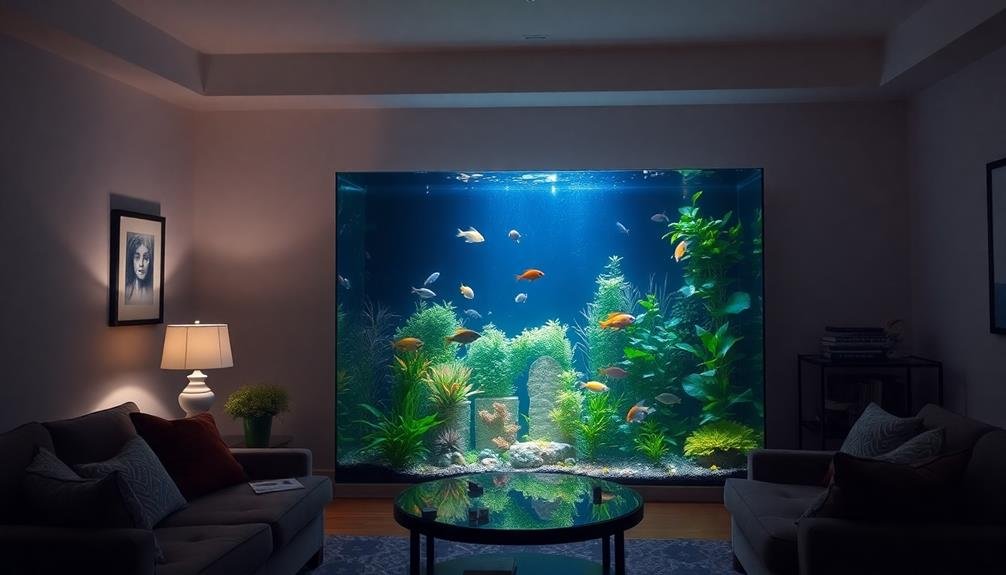
The placement of your aquarium can greatly impact its therapeutic benefits. You'll want to position it where you can easily see and enjoy it throughout the day. Consider placing it in a high-traffic area of your home or office, such as the living room or reception area. This guarantees maximum exposure and allows you to reap the stress-reducing benefits more frequently.
When deciding on the perfect spot, keep in mind factors like natural light, room temperature, and potential distractions. Avoid placing your aquarium near direct sunlight or heating vents, as these can affect water temperature and algae growth. Instead, opt for a location with indirect light that complements the aquarium's lighting system.
Here are some key considerations for positioning your aquarium:
- Eye level: Place the tank at a comfortable viewing height
- Accessibility: Guarantee easy access for maintenance and feeding
- Electrical outlets: Position near power sources for equipment
- Structural support: Choose a sturdy surface that can handle the weight
Mindfulness Practices With Aquariums
Through the mesmerizing world of aquariums, you can enhance your mindfulness practice and find moments of tranquility in your daily life. Incorporate your aquarium into daily meditation routines by focusing on the gentle movements of fish or the subtle dance of aquatic plants. This practice can help ground you in the present moment and reduce stress.
Use your aquarium as a focal point for breathing exercises. As you observe the water's rhythmic flow, synchronize your breath with the gentle currents. This technique can calm your mind and lower your heart rate.
Here are some mindfulness exercises you can try with your aquarium:
| Exercise | Description |
|---|---|
| Color Focus | Concentrate on one fish's colors for 2 minutes |
| Bubble Counting | Count air bubbles as they rise to the surface |
| Fish Movement | Follow a single fish's path for 5 minutes |
| Sound Awareness | Close your eyes and listen to the water sounds |
Frequently Asked Questions
Can Aquariums Help With Specific Mental Health Conditions Like Anxiety or Depression?
Yes, aquariums can help with anxiety and depression. You'll find their calming effects reduce stress and improve mood. They provide a soothing focal point, promote mindfulness, and offer a sense of purpose through care-taking.
How Do Aquariums Compare to Other Stress-Reduction Methods in Effectiveness?
You'll find aquariums are as effective as other stress-reduction methods like meditation or exercise. They're unique in providing a passive, immersive experience that's easy to incorporate into daily life. You'll enjoy their calming effects without much effort.
Are There Any Potential Negative Effects of Having an Aquarium?
You might experience negative effects from an aquarium, such as increased stress due to maintenance, financial strain from ongoing costs, or allergic reactions to fish food. There's also a risk of water damage if the tank leaks.
Can Virtual or Digital Aquariums Provide Similar Stress-Reducing Benefits?
Virtual aquariums can offer stress-reducing benefits, but they're not as effective as real ones. You'll miss out on the tactile experience and live interaction. Still, digital tanks can provide some relaxation when a physical aquarium isn't possible.
How Long Does It Typically Take to Experience Stress Relief From an Aquarium?
You'll often feel immediate stress relief when watching an aquarium. However, for lasting benefits, try observing for 10-15 minutes daily. Over time, you'll notice a cumulative effect, with regular viewing enhancing your overall stress reduction.
In Summary
You've now got all the tools to create your own stress-busting aquarium oasis. Remember, it's not just about the fish—it's the entire experience. From tank size to lighting, every element plays a role in your relaxation. Don't forget to incorporate mindfulness practices as you watch your underwater world. With proper maintenance and care, your aquarium will become a calming focal point in your home, offering a therapeutic escape whenever you need it.





Leave a Reply